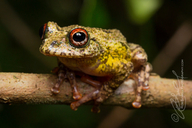|
Description
A medium-sized brown treefrog, SVL 35-40 mm. Tibiotarsal articulation reaches farther than the eye. Hand with a trace of webbing, foot webbing 1(0), 2i/e(0), 3i/e(0), 4i/e(1), 5(0). Males with nuptial pads and a moderately distensible single subgular vocal sac. Dorsal skin granular. Males with whitish nuptial pads and a weakly distensible single subgular vocal sac. Dorsum grey-brown or yellowish brown, typically with irregular blackish spots and markings bordered by light green. Flanks with yellowish large rounded spots. Eye typically with red colour in the iris, especially in the upper half of the outer iris area. Limbs with dark brown bands. Disks of the first and second finger orange. Flanks with light spots. Venter whitish, with dark spots on the throat. Skin on the back granular. Nostrils equidistant between tip of snout and eye. Tympanum indistinct, tympanum/eye ratio is about 1/2. Tibiotarsal articulation reaches beyond the eye. Males with white nuptial pads and a single subgular, moderately distensible vocal sac.
Similar species: Other species such as B. tephraeomystax, B. doulioti, B. idae and B. pauliani can also have yellowish markings on the flanks, but the combination of a granular skin and red iris colour is diagnostic for B. guibei.
Distribution and Habitat
Country distribution from AmphibiaWeb's database: Madagascar
Andasibe, Andranomay forest, Moramanga, Ranomafana National Park. Observed at elevations from 900 to 1100 m around ponds and rivers in primary and secondary rainforest (Cadle and Andreone 2008).
Life History, Abundance, Activity, and Special Behaviors
Call: A relatively long pulsed note. Calling males at Ranomafana were observed during the day from hidden positions next to grass roots in the water.
Eggs and tadpoles (from Andasibe): One female deposited about 200 black sticky eggs, measuring 2 mm in diameter. The entire development in captivity took 2 1/2 to 3 months. Tadpoles live in pools. They are yellowish, covered with brown spots. There is a white spot on the tip of the snout and white lines run from the nostrils to the eyes. Belly silvery. Total length in stage 25: 8-21 mm; in stages 31-40: 26-36 mm. The mouth is small and directed anteroventrally. Eyes are directed laterally. At midlength of the tail, the caudal musculature represents about 1/4 of the total tail height. Tooth formula is 1/4+4//1+1/2 or 1/5+5//1+1/2. Metamorphosing juveniles measure 11-14 mm from snout to vent. They are beige or silvery grey, covered with irregular black spots and markings, bordered with green. Disks of fingers and toes yellow. Iris orange. Skin warted.
Reproduces in swamps and ponds in or near forest. Explosive breeding behaviour after heavy rains.
Trends and Threats
It occurs in the Réserve Spéciale d’Analamazaotra and Parc National de Ranomafana (Cadle and Andreone 2008). Possible reasons for amphibian decline General habitat alteration and loss
Habitat modification from deforestation, or logging related activities
Intensified agriculture or grazing
Habitat fragmentation
Comments
Taken with permission from Glaw and Vences (2007).
References
Cadle, J. and Andreone, F. (2008). Boophis guibei. In: IUCN 2008. 2008 IUCN Red List of Threatened Species. www.iucnredlist.org. Downloaded on 31 March 2009.
Glaw, F. and Vences, M. (1994). Amphibians and Reptiles of Madagascar. M. Vences and F. Glaw Verlags GbR., Köln.
Glaw, F., and Vences, M. (2007). Field Guide to the Amphibians and Reptiles of Madagascar. Third Edition. Vences and Glaw Verlag, Köln.
Originally submitted by: Miguel Vences and Frank Glaw (first posted 2000-10-30)
Edited by: Henry Zhu (2009-05-05)Species Account Citation: AmphibiaWeb 2009 Boophis guibei <https://amphibiaweb.org/species/4342> University of California, Berkeley, CA, USA. Accessed Apr 1, 2025.
Feedback or comments about this page.
Citation: AmphibiaWeb. 2025. <https://amphibiaweb.org> University of California, Berkeley, CA, USA. Accessed 1 Apr 2025.
AmphibiaWeb's policy on data use.
| 